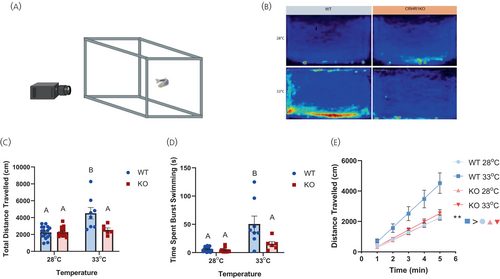Fig. 2 Lack of Crhr1 inhibits thermal stress-mediated zebrafish locomotory activity. (A) Diagram of the experimental setup for the vertical swim assessment. The recording camera was positioned to record from the side of the novel tank with the zebrafish. (B) Representative heatmap of the mean position of each treatment in the novel tank environment during the 5 min recording period, as observed by the camera field of view shown in (A). The light blue (less activity), yellow (more activity) and red (most activity) regions of the heatmap represent the overall activity of the fish in the tanks. (C) Total distance travelled by WT and crhr1−/− zebrafish exposed to a novel tank environment at 28°C or 33°C for 5 mins. (D) Total time zebrafish spent burst swimming, defined as swimming speeds greater than 90% of the average speed of each fish during the 5 min recording period. (E) Distance travelled by zebrafish per minute over the 5 min period. Adult zebrafish were transferred from their housing system to a novel tank containing either 28°C or 33°C system water. Video recording started immediately after placement of fish and lasted for 5 min. Behaviour was analysed using Noldus Ethovision XT 14. (B–D) Bars with different letters denote significant difference (Two-way ANOVA, Holm–Sidak post hoc test, p < 0.05). (E) Asterisks denote significant difference between treatment groups (linear regression, **p < 0.01). Crhr1, corticotropin-releasing hormone receptor 1; KO, crhr1-/-; WT, wildtype.
Image
Figure Caption
Figure Data
Acknowledgments
This image is the copyrighted work of the attributed author or publisher, and
ZFIN has permission only to display this image to its users.
Additional permissions should be obtained from the applicable author or publisher of the image.
Full text @ J. Neuroendocrinol.

